AACtual Therapy: Breakthroughs with Bubbles!
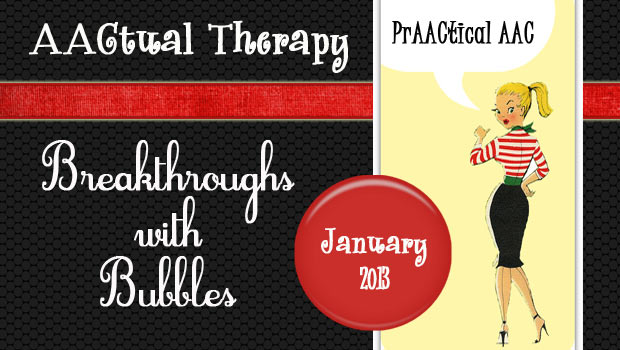
We couldn’t be happier that one of our first AACtual Therapists is Tanna Neufeld, a south Floridian on loan to the Pacific Northwest. Tanna was with us as a graduate student many years ago, and went on to build a fantastic reputation in our community for her excellent clinical skills. It was South Florida’s loss when she left last year and moved across the continent. (I know at least a few people scheming of ways to get her back.) Tanna is now working at the Children’s Therapy Center in Seattle. Tanna blogs at SNEAK Outside the Box and My Blind Side. You can read more about her at the end of this post, in which Tanna talks about using bubbles in her AAC therapy sessions.
AAC Breakthroughs with Bubbles!
When I first started using core vocabulary boards with my kids, I didn’t really know where to start. It was really difficult breaking out of the standard carrier phrases and requests that were much more familiar and a whole lot easier to implement. I remember how impossible it seemed to fit these seemingly obscure vocabulary words into my therapy sessions and still manage to create some fun for my kids. Even more daunting, it seemed, was the task of teaching parents how to target these “abstract” concepts during play and daily routines at home. I decided to start with a bit of the basics to help me ease into this unfamiliar territory. What better tool to take a little bit of the scary out of implementing AAC then a tried and true, go-to ice breaker: bubbles. 🙂 Kids love them, every household has them, AND, with the right visual supports and language models, bubbles can be an excellent way for beginning communicators (and their communication partners) to practice core vocabulary!
I started out with lots of awesome bubble making machinery…
Blowing bubbles in their purest form is fun in and of itself. BUT, I love it when I can add some spice, and with that spice, a whole lot of opportunities to learn new vocabulary!For some kids, a simple no spill tumbler will be just enough. But for those who are ready for a little more variety, adding some different tools and play routines can really set the stage for versatile communication. I use different kinds of bubbles (small, party favor bubbles, no spill tumblers, large bubble wand style bubbles) and oodles of bubble accessories (different sizes and shapes of bubble wands and bubble blowing options, such as switch activated bubble machines, bubble guns, and bubble whistles). Did you know that there are even bubbles in rainbow colors, bubbles you can eat, bubbles that don’t pop? The possibilities seem endless, and with those possibilities, oh the vocabulary!
Then I add a few really good words…
For those kids with AAC systems in place, I prepare each child’s communication system, displaying core vocabulary words (just beyond his/her current communication level so there is lots of room for modeling and word combinations) and fringe vocabulary specifically related to the activity (in this case, bubbles). For most, if not all of my kids (even those with a communication device), I like to use static communication boards with core words on the base page and a fringe row along the top, similar to a Pixon book. This keeps all of the words I need for aided language input (aided language stimulation) at my fingertips, allows me to easily model word combinations for those kids who are ready, and provides an organized way to utilize powerful core words with motivating activity-based, fringe vocabulary.
For some kids, I focus on highlighting specific, early emerging, highly potent core words, like “go”, “mine”, and “no”. For other kids, I focus on expanding communication functions with later emerging word forms by providing new vocabulary models during this highly preferred, highly familiar activity. My goals for this kind of activity include exposing each child to core words in action through aided language input, expanding communication functions (taking communication beyond the initial request, and keeping the conversation going!) and modeling early word combinations.
Some of the core vocabulary words that I have successfully targeted during this activity include those listed below.
Nouns
I
Me/my/mine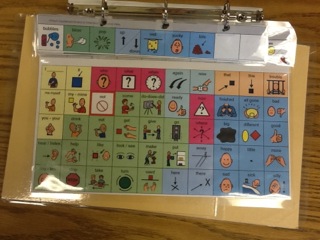
you
Verbs
come
do
go
help
look/see
Adverbs
again
no
away
Adjectives
done
gone
big
little (not big)
different
more
silly
Prepositions
up
down
here
And then there’s the fringe!
Colors (if you’re using those rainbow bubbles)
wet
yucky
blow
pop
stomp
catch
jump
And word combinations for expanded communication functions!
my bubbles
I do
You do
help me
bubbles up
big bubbles
come here bubbles
go away bubbles
blow again
pop again
more bubbles
more big bubbles
look bubbles
where bubbles?
Don’t forget to add a little repetition with variety…
My kids love doing silly things with their bubbles. We chomp them, stomp them, wave them away, wave them to come, pop them on our noses, pop them on our tummies, dance, jump, catch, and blow! We blow bubbles to our friends, our mommies, and our daddies. We learn to take turns, learn about wet and dry hands, yucky tastes and textures, and what it means to be “all gone”. To me, the fun and learning with bubbles is just beginning after you blow the first round.
What I love most about this simple activity is that bubbles provide such a natural platform for creating communication temptations. Bubble play is also an activity that does not require a lot of precursor skills to participate, its motivating and enjoyable, social, inexpensive, and easy for parents to carry over. One of the challenges I have experienced when targeting core words within this activity is feeling a bit clumsy when juggling visual supports, especially with really active little ones. Also, for some kids, a core board with this many symbols at once was a bit overwhelming. To address the little ones at earlier stages, I used masked boards, cut out symbols to reduce the array even further, and even placed single core word symbols on a communication apron for focused modeling. The amount of words that I modeled/targeted varied with the language level of each child and their interests at the moment-some were more interested in action (e.g., go, pop, up), others in sensory properties (e.g., yucky, wet, sticky).
For some kids, aided language input was where it ended for several sessions and that felt successful in its own way, even if the child never actually pointed to a picture to express himself. What I noticed with these early language learners is that each session was a building block for the next and eventually, all of my kids were absorbing my visual models and using new words that they never knew before. How exciting!!
More About Tanna Neufeld
Most might say that you aren’t defined by your disabilities, and in almost all cases, I completely agree. However, I don’t know where I would be, or who I would be, if it weren’t for the unique experiences I have had because of my disability. When I was 15, I was diagnosed with a rare, juvenile form of Macular Degeneration, known as Stargardts Macular Dystrophy (SMD). As a result of progressive vision loss, I am currently considered “legally blind”, although, I like to think of it more as “partially sighted”. As a high school and college student, I struggled endlessly with reading small print textbooks, seeing the professor’s presentation slides, and simply getting around independently in the community. The first piece of assistive technology (AT) that I received was a dome magnifier (and I still have it!). I remember the joy and relief I felt at finally being able to read print I hadn’t seen for years! I have since been fortunate to live in an age where AT for visual impairments has made leaps over the dome magnifier. I have personally reaped the benefits of these technological advances and I couldn’t imagine my life without these vital tools. Technology got me through high school, college, and grad school, and now, technology helps me do my job every day.
I am so fortunate to be able to share my perspective on AT and disability with kids and their families. I am a speech-language pathologist, born and raised in Hollywood, Florida and currently living in the Seattle area. I obtained a Masters in Speech-Language Pathology from Nova Southeastern University (NSU) in Ft. Lauderdale, where I also worked as a lab assistant in NSU’s AAC/AT Lab during my 3 years of graduate school. It was here, through amazing hands-on experiences and mentorship, that I became enthralled with the power of technology in the therapeutic field. After graduating, I built my clinical skills in the areas of AAC and AT as a full time therapist at Pediatric Therapy Associates (PTA) in Plantation, Florida. Being a part of the PTA family for 4 years allowed me to build amazing personal, professional, and therapeutic relationships with wonderful families and gifted therapists. I served as AAC/AT specialist at PTA, while also doing private consultations in the school system and in the home for families in need of these specialized services. I have presented on AAC and AT at the Florida Cleft-Palate and Craniofacial Symposium, as well as intra-office trainings and seminars for PTA families and professionals. After relocating to Seattle late last year, I started SNEAK outside the box (SNEAKotb) to stay connected with the colleagues and families I left behind, and to continue enjoying my favorite part of being an SLP, sharing valuable resources to help special kids. In addition to authoring SNEAKotb, I currently work as a full time speech therapist at Children’s Therapy Center in the Seattle Area.
If you have Boardmaker, you can download Tanna’s boards here and here.
Filed under: PrAACtical Thinking
Tagged With: AACtual therapy, activities, download, goals
This post was written by Carole Zangari

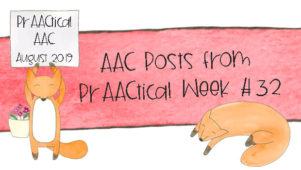
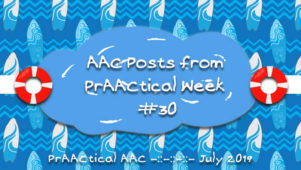
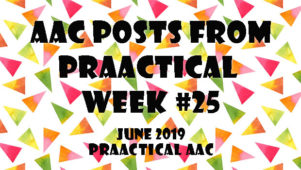
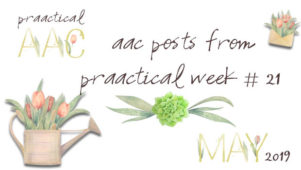
4 Comments
Hello,
I am trying to access the Boardmaker Boards that are mentioned above but the files are downloading as x.pages files and not as x.bm2 files.
Could you please correct this?
Thanks
Alison, thanks for alerting us to this. I think it is fixed now, but if not, let me know.
This is fantastic, thank you!
Bubbles and my portable DVD player – my two go-to assessment tools! It’s amazing how far you can get with just a bottle of bubbles. I particularly like the Gymboree bubbles. They last longer and have no soap in them so they’re easier on the eyes and tongue – which inevitably happens.